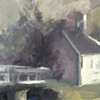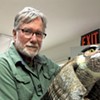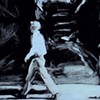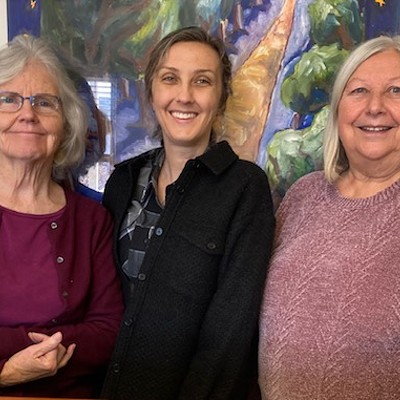Published October 23, 2002 at 8:12 p.m.
The great American photographer Arnold Newman reportedly said that "photography is one percent talent and 99 percent moving furniture." While few might agree entirely with that modest statement, the mention of household goods does have significance. Newman was the innovator of the "environmental portrait" -- the picture taken in a natural setting rather than in the studio. After decades of stiff, formal photographs emulating centuries of stiff, formal oil paintings, the idea that a subject could be depicted relaxing, say, in their living room or backyard was radical and refreshing.
When Jamie Cope studied photography with Newman at the Maryland Institute College of Art back in the 1960s, she took to heart his straightforward advice: "Just photograph the way you want to." Now 81 and living in Montpelier, Cope is still doing exactly that. Some of the photos in her new book, entitled simply Portraits, were taken last summer; others date back to the late '60s, which means the 63 black-and-white compositions span her professional career. So far.
Cope began fiddling around with a Kodak Brownie she found abandoned in Italy when she and her family were living there in the '50s. She shot everything, tourist-style, but says she was always attracted to faces. Later, at the Art Institute, she began to focus primarily on the portrait. "I prefer photographing people more than anything else," she says simply. And she graduated to Hasselblad and Nikon.
Ironically, it was Cope's experience with age discrimination -- she was a "late bloomer" as an artist -- that led to some of her most rewarding work. She has become known for her photographs of older people, including a series of distinguished, "high achieving" elder Bostonians and another of Vermonters. An exhibit of the latter work toured the Green Mountain State, including a stint at Burlington's Fleming Museum in the late '80s. Last summer, Senator Patrick Leahy sponsored her photography show at the Senate building in Washington, D.C.
Over the years Cope pursued jobs as a newspaper columnist, radio show host and TV producer -- all focused on elders and matters important to that demographic. As an active, productive senior citizen herself, Cope could hardly be a better role model. She has also worked in public relations for the state's department on aging, and then for travel and tourism. Throughout all her jobs, Cope kept shooting. She continues to do her own darkroom work. "I like to feel responsible for each phase of an image, from its conception to the final print," she writes in Portraits, "so when I see it exhibited or published I know it is my own interpretation."
Four decades of work in several states are represented in her slim, softbound volume, which was beautifully printed at the Stinehour Press in Lun-enberg. The photos are of children and adults, shot indoors and out, posed and seemingly serendipitous. Some are urban -- such as "Sis-ters," three dark-haired girls standing against a grafitti'd concrete wall -- and others sylvan, like "Sayers in ferns," a preadolescent nude girl reclining face-down in the woods. Cope's own children, Cameron and Tami, appear as adults. In only about half the pictures are her subjects looking at the camera.
A casual shot like "Sisters" would not seem to have much in common with a striking formal portrait such as "Arcangelo Casciei, Dean, Boston Architectural School." The wheelchair-bound "Deborah Lisi-Baker, Director of Vermont Center for Independent Living" is a conceptual and visual contrast with "Anita," a close-up shot of a young woman sunbathing on a beach, her hair strewn across the sand in the shadow of spiky grasses. And yet a consistent vision is evident across the years and environs and subjects in Portraits. Cope herself suggests in her introduction, "Technically, I found I had a visual understanding of the tonal range of black and white film... I believe this sensitivity must have come from growing up in Hollywood during the 1920s and into the early 1940s when black and white films flourished."
Cope's portraits are not cinematic, however, but naturalistic. Indoors or out, her use of light is magnificent and uncontrived. Some of her subjects seem bathed in light; others seem to be the source of it. In the darkroom, Cope finds her way to saturated, rich tones with a full range of grays. One of the most beautiful portraits appears on her book's cover: artist Maud Morgan, reclining on a rattan settee, her white hair and aquiline profile illuminating the picture, her attitude both rakish and elegant. This photograph, and one of strobe-light inventor Harold Edgerton in his lab at MIT, have both been printed in limited editions by the Palm Press.
Other than a two-page biographical introduction, Portraits is all pictures. A few of them have informative captions -- "Lawrence C. Sullivan, Executive Secretary-Treasurer, AFL-CIO Labor Council," for example. Others reveal less: "Hugo at Wisconsin camp"; "Harry Thompson, Naturalist." Some of the pages divulge no names at all, and the viewer is left to wonder who the cute little kids in "Sister and Brother" might be, or the dramatic, androgynous nude with the shaved head named simply "Morgan." No photos are dated.
Cope concedes this paucity of explanation was a "mistake" -- "It was my first book," she offers apologetically. But she also contends, "I didn't want to be distracted by a lot of words. The photo should fill you in; each is an emotional experience. If you just sit down with that book, or any book of photography, that's what it's all about."
More By This Author
Speaking of...
-

Q&A: Catching Up With the Champlain Valley Quilt Guild
Apr 10, 2024 -

Video: The Champlain Valley Quilt Guild Prepares for Its Biennial Quilt Show
Apr 4, 2024 -

Q&A: Meet a Family in Waterbury That Embraces Halloween Year-Round
Feb 14, 2024 -

Video: Goth Family in Waterbury: Sarah, Jay and Zarek Vogelsang-Card
Feb 8, 2024 -

Q&A: Art Entrepreneurs Tessa and Torrey Valyou Celebrate 15 Years of New Duds
Oct 11, 2023 - More »
Comments
Comments are closed.
From 2014-2020, Seven Days allowed readers to comment on all stories posted on our website. While we've appreciated the suggestions and insights, right now Seven Days is prioritizing our core mission — producing high-quality, responsible local journalism — over moderating online debates between readers.
To criticize, correct or praise our reporting, please send us a letter to the editor or send us a tip. We’ll check it out and report the results.
Online comments may return when we have better tech tools for managing them. Thanks for reading.













































